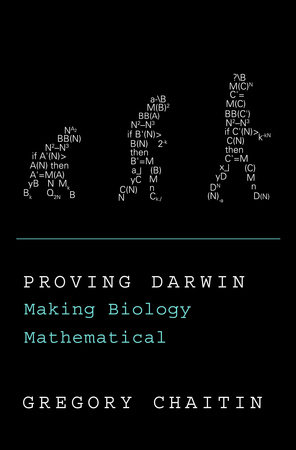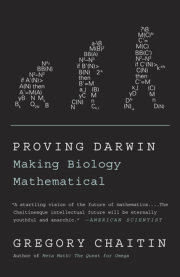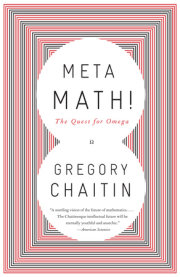One
Introduction: Overview of Proving Darwin
Like many pure mathematicians, I like giving “chalk” talks: improvised talks given on a blackboard or white- board using a minimum of technological assistance. Another strategy is for me to fill the board with what I want to cover just before I start to lecture, while people are still coming in, so that they can take in all the key ideas at a glance. In a large auditorium, however, a projector is necessary, or nobody will see anything.
On the facing page you can see me giving an overview of this book in a large auditorium at the Federal University of Rio Grande do Sul in southern Brazil. The four slides I prepared are on pages 5 and 6. They summarize Chapters 2 to 4, which outline my strategy for making biology mathematical. After you finish reading these chapters, you should review the slides. Then they will make more sense.
You’ve heard people refer to DNA as a computer program? Well, that’s the whole idea: to make this metaphor into a mathematical theory of evolution. In fact, it turns out that the mathematical tools for doing this were already available in the 1970s. More precisely, we will treat evolution as a random walk in software space. Random walks are an idea that mathematicians feel comfortable with, although the space we are walking around in at random is bigger than usual.
I call this proposed new field “metabiology” because it is a highly simplified version of real biology—otherwise I wouldn’t be able to prove any theorems. These theorems are presented in Chapter 5, which is the climax of the book, and was a talk that I gave at the Santa Fe Institute. Chapters 6 to 8 discuss the broader significance of metabiology, theological, political and epistemological. And then there are two appendices.
In the first appendix you can read the crucial section on self-reproducing automata in John von Neumann’s far-seeing “DNA = Software” paper that influenced Sydney Brenner, who in turn influenced Francis Crick—a remarkable fact that I only discovered while working on this book. And the second appendix gives some additional mathematical details that may be of interest to experts.
Finally, I give a short list of suggested further reading, some books and a few articles that are important if you want to really understand metabiology. These are the books and articles that helped me the most to come up with a strategy for making biology mathematical, plus a few more related items that I threw in just for the fun of it. Enjoy them all!
Copyright © 2012 by Gregory Chaitin. All rights reserved. No part of this excerpt may be reproduced or reprinted without permission in writing from the publisher.









